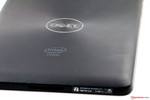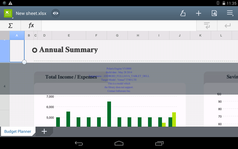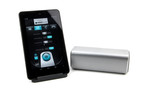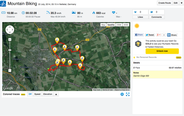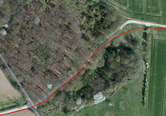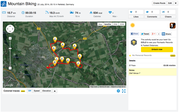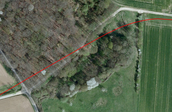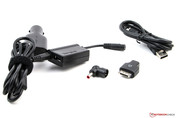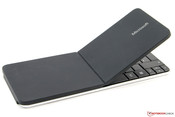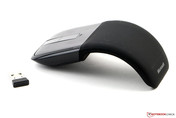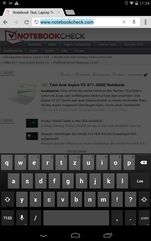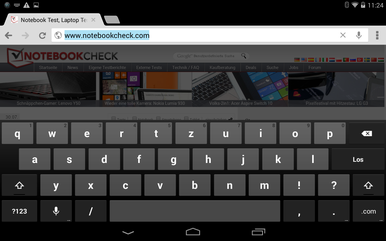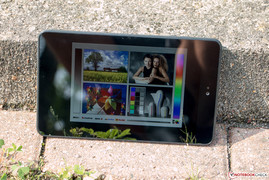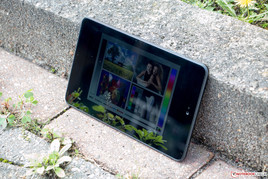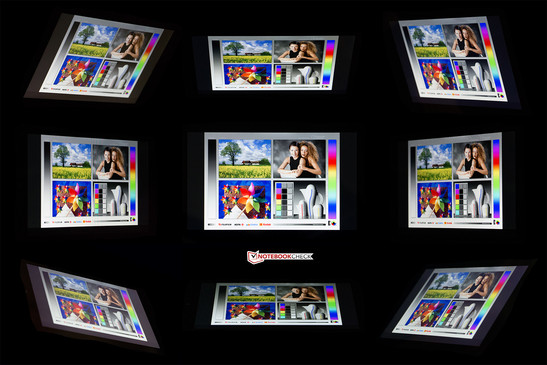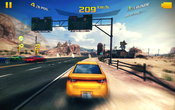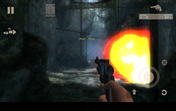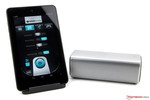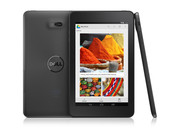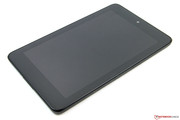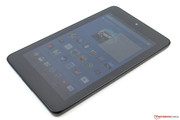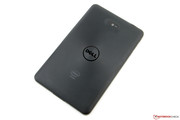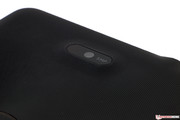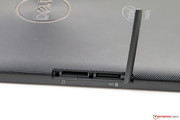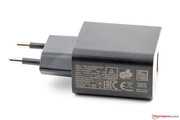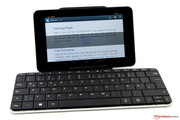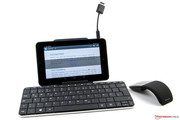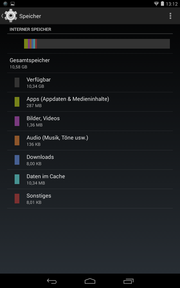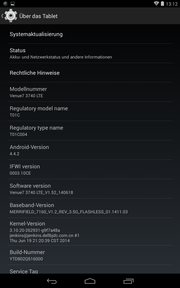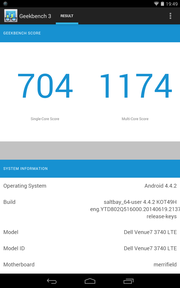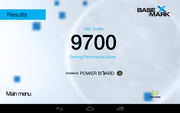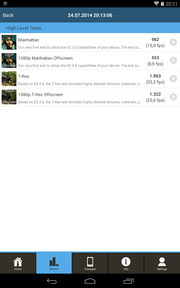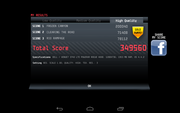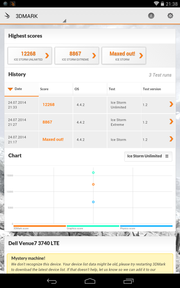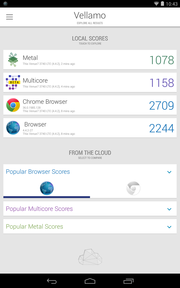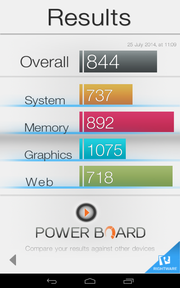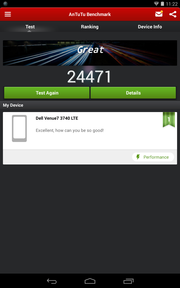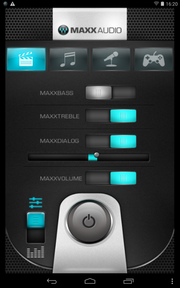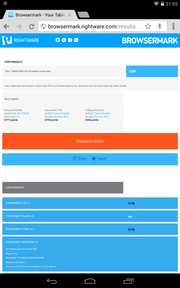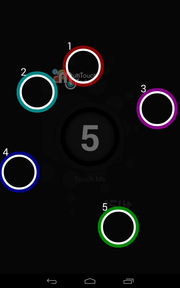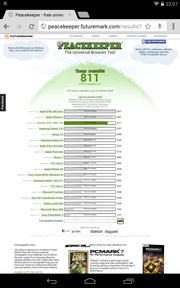Dell Venue 7 LTE Tablet Review

For the original German review, see here.
The American computer giant sticks to its Android line and again relies on processors from Intel for the Dell Venue 7. The Atom CPU is based on the new Merrifield platform. For the first time, the chip builder does not use its own graphics solution but integrates a unit that offers a considerable power boost from Imagination Technologies. Besides that, the system features 2 GB of working memory, 16 GB of flash storage, and the latest Google Android 4.4 KitKat. Thus, it provides a good configuration, and the LTE module is the cherry on the cake. The price will probably range around 200 Euros (~$267), but an exact price could not yet be called. It will first be announced directly before its market launch, so not earlier than September 2014.
Not even the value-for-money breaker Google's Nexus 7 can keep up with that, which costs 349 Euros (~$466) in the LTE version. Asus' Fonepad ME372CG for currently 180 Euros (~$240) is a bit more affordable, but it also relies on older software and hardware. Like Acer's Iconia B1-721 it only connects to the Internet via HSPA+. Other rivals that lack mobile Internet options would be Yarvik's Xenta 7ic and Amazon's Kindle Fire HDX 7. Our report reveals how Dell's Venue 7 LTE fares compared with the competition.
Case
The casing of Dell's Venue 7 LTE has a thickness of just under nine millimeters and is roughly as heavy as the Nexus 7 with 295 grams. It is pleasant to hold, and the circular rubber-coating on the back gives it a very secure grip. Although the fingerprints on the back are not as obvious as on other materials, they are still visible.
The stiffness of the Venue 7 is very good. The device neither twisted to an undue extent nor did it produce noises during our tests. However, it proved to be quite pressure sensitive; when we pressed our finger firmly on the back, the screen displayed a marginal wave formation. The display bezel was even more pressure sensitive. Simply holding it with a firmer grip resulted in noticeable wave formation. This effect became more obvious the darker the surroundings were.
The casing makes an easy-to-remove impression. However, it is closed tightly. The gaps are relatively evenly spaced, and only minor irregularities were ascertained.
Connectivity
The connectivity of Dell's Venue 7 LTE is not exceptional but nevertheless quite decent considering its category. Though it does not sport an interface for external video output, the image can be transmitted via both Miracast and Wireless Display. The micro-USB 2.0 port is used for recharging the device and data sharing with a computer. Additionally, the port supports OTG so that peripherals like USB sticks or mice can be connected.
The microSD slot supports storage cards with a capacity up to of 64 GB (SDXC) and is easy to access. The slot for the micro-SIM card is located directly beside it. Both slots have a spring-loaded ejector which makes taking out the card easy.
Software
Dell's Venue 7 LTE is based on an unmodified version of Google's Android 4.4.2 KitKat operating system. The app CamCard is part of the included software and enables taking a picture of business cards and saving the data directly into the phone book. That also functioned quite well. The application only had minor problems with motive cards. However, the program recognizes markers for augmented reality. The app MaxxAudio provides a sound optimization tool.
Every owner of a Venue 7 LTE additionally receives 20 GB of Dropbox storage for one year. App2SD is not supported.
Communication & GPS
Dell's Venue 7 LTE features a cutting-edge Wi-Fi module that supports the IEEE 802.11 a/b/g/n/ac standards. Thus, it transmits in both the 2.4 and 5.0 GHz frequency bands. The range of the components is, however, only middling. Only a distance of 20 meters away from the router caused comparatively high losses.
The tablet can also connect to mobile Internet via either HSPA+ or LTE. Unfortunately, no detailed technical specifications about the WWAN module were available at the time of writing. We will, however, submit these as soon as possible.
Bluetooth 4.0 is also installed and functions quite well. We only noticed a slightly mismatched lip-sync in the audio output when streaming HD content from the web over Dell's Bluetooth speaker. However, users who play videos locally will not have any problems even when other input devices are connected to Dell's Venue 7. Users who order Dell's Bluetooth speaker will be annoyed about the lack of NFC because the portable speaker supports quick and easy near-field coupling.
The signal of the GPS receiver in Dell's Venue 7 LTE is not particularly strong and cannot find satellites indoors. That happens quite fast outdoors. Compared with Garmin's Edge 500 GPS-enabled bike computer, the position data is not as accurate but still useful because the overall deviation is fairly low in total. It looks more severe on the enlarged sections than it actually is.
Cameras
The webcam of Dell's Venue 7 LTE has a resolution of 1280x720 pixels and is only intended for video conferencing. It fulfills its purpose, but the color reproduction and sharpness are unsatisfactory.
The rear-facing, primary camera does a much better job. Its lens achieves resolutions of up to 5 MP (2560x1920 MP, 4:3). The pictures are agreeably focused in the center in good light, but the sharpness decreases towards the edges. The colors look balanced but have a light bluish cast. There is no flash so that pictures quickly become noisy and blurry in poor ambient light.
The camera records videos with up to 1920x1080 pixels (Full HD, 1080p). They are not compelling though. The pictures are affected by a light-grayish cast, and they do not look really focused. The audio quality is also only middling.
Accessories
The accessories Dell includes for its Venue 7 LTE does not reveal any surprises. Besides a modular power supply with a power output of 10 watts (5 volts, 2 Ampere), the manufacturer includes a USB cable and quick-start guide for the tablet.
Dell optionally offers a case (46 Euros, ~$61) and a Bluetooth speaker with integrated battery (83 Euros, ~$110). Third-party accessories can also be used without problems.
Warranty
Dell's Venue 7 LTE comes with a 12-month warranty. Warranty upgrades for up to three years can be purchased optionally. An additional 155 Euros (~$207) is charged when combined with ProSupport. Theft or damage protection is also available and costs up to 100 Euros (~$133). Private customers within the EU also have the advantage of the standard European two-year warranty.
Input Devices & Controls
The capacitive touchscreen in Dell's Venue 7 LTE supports up to five gestures at the same time. Its gliding properties are decent, but we detected a minor bump that was not noticed adversely in practical use though. The inputs were also implemented accurately, and it was rarely necessary to reenter them because they apparently were not accepted.
Dell uses Google's standard layout for the virtual keyboard. It is very clearly arranged and allows reaching all commonly used characters without problems.
The power button and volume rocker are metal and feature a short drop. Their pressure point is very clear.
Display
The screen in Dell's Venue 7 is based on IPS technology. It has a 7-inch size and a resolution of 1280x800 pixels. That corresponds to an aspect ratio of 16:10 and a pixel density of approx. 216 ppi. Thus, most content is displayed sufficiently sharp and only very small-scaled texts degenerate to clumps of pixels.
The screen's maximum brightness of 294 cd/m² is not exceptional, and the illumination of 79% is also rather weak. However, this imbalance is only visible in single-colored contents. Yarvik's Xenta has an even lower brightness (max. 188 cd/m², 81%), and Asus' Fonepad is only marginally brighter (345 cd/m², 70%). The Nexus 7 does a better job (max. 549 cd/m², 87%) here.
| |||||||||||||||||||||||||
Brightness Distribution: 79 %
Center on Battery: 276 cd/m²
Contrast: 708:1 (Black: 0.39 cd/m²)
ΔE ColorChecker Calman: 4.62 | ∀{0.5-29.43 Ø4.79}
ΔE Greyscale Calman: 5 | ∀{0.09-98 Ø5}
Gamma: 2.18
CCT: 7264 K
The black level of 0.39 cd/m² is within a decent range, and the contrast of 708:1 is also very good. Dell's Venue 7 still achieves the best rates in the comparison field here. The Nexus 7 (1.02 cd/m², 513:1) has to pay the price for its high brightness, and Asus' tablet (0.53 cd/m², 594:1) cannot quite compete here either.
The color accuracy is also good and does not show any major shortcomings. Both the mixed colors and the grayscale (both dE 5) do not exhibit any anomalies. Only a minor greenish cast can be measured, but it is not distracting in routine use.
The comparatively low brightness of the screen in Dell's Venue 7 struggles a bit in outdoor use. It is particularly difficult to recognize anything on the reflective screen in direct, bright sunlight. However, the good contrast ratio is noticed favorably under just light clouds. The brightness sensor functions very reliably and responds swiftly.
Performance
Dell's Venue 7 is powered by Intel's Atom Z3460 that is based on the latest Merrifield architecture. The dual-core processor clocks with a maximum of 1.6 GHz and is capable of Hyper-Threading, and thus it can process up to four threads simultaneously. 2 GB of working memory is also part of the bundle. A PowerVR G6400 is used for graphical computation. It clocks with 457 MHz. The version without LTE features the same configuration, but it only has a 1 GB RAM.
The SoC's pure processing power is not exactly tremendous but provides a decent system performance anyway. It cannot compete with swifter CPUs like the Snapdragon 800 or 801 though. That is primarily due to its much lower clock rate because its per-MHz performance is higher.
The graphics unit no longer comes from Intel itself, but now from Imagination Technologies. The PowerVR G6400 supplies an outstanding GPU performance and does not need to fear the competition. It is only defeated by current top GPUs like in the iPad Air (PowerVR G6430) or Galaxy S5 (Adreno 330 @ 578 MHz). The G6400 also supports OpenGL ES 3.1 which makes it quite future-proof. The poor scores in 3DMark are deceiving because they are only worse due to the CPU's slower performance.
| AnTuTu v4 - Total Score (sort by value) | |
| Dell Venue 7 | |
| Acer Iconia B1-721 | |
| Asus Fonepad ME372CG | |
| Amazon Kindle Fire HDX 7 inch | |
| Samsung Galaxy S5 | |
| 3DMark | |
| 1280x720 offscreen Ice Storm Unlimited Score (sort by value) | |
| Dell Venue 7 | |
| Acer Iconia B1-721 | |
| Apple iPad Air 1 2013 | |
| Samsung Galaxy S5 | |
| 1280x720 offscreen Ice Storm Unlimited Graphics Score (sort by value) | |
| Dell Venue 7 | |
| Acer Iconia B1-721 | |
| Apple iPad Air 1 2013 | |
| Samsung Galaxy S5 | |
| 1280x720 offscreen Ice Storm Unlimited Physics (sort by value) | |
| Dell Venue 7 | |
| Acer Iconia B1-721 | |
| Apple iPad Air 1 2013 | |
| Samsung Galaxy S5 | |
| GFXBench (DX / GLBenchmark) 2.7 | |
| 1920x1080 T-Rex Offscreen (sort by value) | |
| Dell Venue 7 | |
| Google Nexus 7 2013 | |
| Acer Iconia B1-721 | |
| Asus Fonepad ME372CG | |
| Apple iPad Air 1 2013 | |
| Samsung Galaxy S5 | |
| T-Rex Onscreen (sort by value) | |
| Dell Venue 7 | |
| Google Nexus 7 2013 | |
| Acer Iconia B1-721 | |
| Asus Fonepad ME372CG | |
| Apple iPad Air 1 2013 | |
| Samsung Galaxy S5 | |
Internet browsing with Dell's Venue 7 is smooth. The preloaded Google Chrome Browser (version 36) ensures a swift performance that clearly outperforms some rivals. Only the Kindle Fire HDX 7 defeated the review sample.
| Peacekeeper - --- (sort by value) | |
| Dell Venue 7 | |
| Acer Iconia B1-721 | |
| Asus Fonepad ME372CG | |
| Google Nexus 7 2013 | |
| Amazon Kindle Fire HDX 7 inch | |
| Octane V2 - Total Score (sort by value) | |
| Dell Venue 7 | |
| Acer Iconia B1-721 | |
| Sunspider - 1.0 Total Score (sort by value) | |
| Dell Venue 7 | |
| Acer Iconia B1-721 | |
| Asus Fonepad ME372CG | |
| Google Nexus 7 2013 | |
| Amazon Kindle Fire HDX 7 inch | |
| WebXPRT 2013 - Overall (sort by value) | |
| Dell Venue 7 | |
| Acer Iconia B1-721 | |
| Asus Fonepad ME372CG | |
| Amazon Kindle Fire HDX 7 inch | |
* ... smaller is better
The user has 10 of the 16 GB eMMC flash storage available for free use. Multimedia data can additionally be saved on a microSD card should that not be enough. A maximum of 64 GB (SDXC) can be inserted.
The storage device's speed is also compelling. The Venue 7 is extremely fast particularly in sequential writing of data. It only exhibits average qualities in reading and writing small data blocks.
| AndroBench 3-5 | |
| Sequential Read 256KB (sort by value) | |
| Dell Venue 7 | |
| Yarvik Xenta 7ic | |
| Asus Fonepad ME372CG | |
| Google Nexus 7 2013 | |
| Acer Iconia B1-721 | |
| Amazon Kindle Fire HDX 7 inch | |
| Sequential Write 256KB (sort by value) | |
| Dell Venue 7 | |
| Yarvik Xenta 7ic | |
| Asus Fonepad ME372CG | |
| Google Nexus 7 2013 | |
| Acer Iconia B1-721 | |
| Amazon Kindle Fire HDX 7 inch | |
| Random Read 4KB (sort by value) | |
| Dell Venue 7 | |
| Yarvik Xenta 7ic | |
| Asus Fonepad ME372CG | |
| Google Nexus 7 2013 | |
| Acer Iconia B1-721 | |
| Amazon Kindle Fire HDX 7 inch | |
| Random Write 4KB (sort by value) | |
| Dell Venue 7 | |
| Yarvik Xenta 7ic | |
| Asus Fonepad ME372CG | |
| Google Nexus 7 2013 | |
| Acer Iconia B1-721 | |
| Amazon Kindle Fire HDX 7 inch | |
| PassMark PerformanceTest Mobile V1 - Memory Tests (sort by value) | |
| Dell Venue 7 | |
| Asus Fonepad ME372CG | |
| Google Nexus 7 2013 | |
| Acer Iconia B1-721 | |
Games
The speedy PowerVR G6400 graphics unit is also very suitable for gaming. Because it supports OpenGL ES 3.1 and DirectX 10, even future titles will still look really good on Dell's Venue 7. Current 3D games like Asphalt 8 are no problem for the tablet either. We only noticed minor stuttering using ultra details (maximum) in The Descent that already relies on OpenGL ES 3.0.
The good touchscreen and the impeccably functioning accelerometer successfully round off the gaming fun.
Emissions
Temperature
Dell's Venue 7 LTE already gets lukewarm when idling and reaches a temperature of up to 36.5 °C. The temperatures only increase marginally under load though, and climb to a maximum of 40.3 °C. Neither rate is critical.
The contenders are roughly on par. Only the Nexus 7 is considerably warmer and reaches top rates of up to 45.8 °C in the comparison field.
(±) The maximum temperature on the upper side is 40.3 °C / 105 F, compared to the average of 33.7 °C / 93 F, ranging from 20.7 to 53.2 °C for the class Tablet.
(+) The bottom heats up to a maximum of 39.7 °C / 103 F, compared to the average of 33.2 °C / 92 F
(±) In idle usage, the average temperature for the upper side is 32.4 °C / 90 F, compared to the device average of 30 °C / 86 F.
Speakers
The position of the speaker in Dell's Venue 7 is unfavorable and is quickly covered by a hand when held in landscape mode. The speaker's sound quality is only middling. It is permanently accompanied by light static noise, and the tones are also slightly distorted. Besides that, a cracking noise is heard occasionally. Users who turn up the volume will notice that the speaker's quality is on a consistently low level. The right settings in the MaxxAudio tool reduce these effects a bit, but they cannot prevent them.
Energy Management
Power Consumption
Just the idle power consumption of Dell's Venue 7 LTE is quite high and ranges between 1.9 and 4.0 watts. Other tablets like Asus' Fonepad (0.7 - 1.9 watts) consume considerably less power.
However, the consumption does not climb much higher and reaches a maximum of 6.8 watts under permanent load. That is a very decent rate considering the strong GPU. The power supply's output of 10 watts is sufficient for that, and it is both TÜV (German Association for Technical Inspection) and GS (quality seal from TÜV) certified.
| Off / Standby | |
| Idle | |
| Load |
|
Key:
min: | |
Battery Runtime
The strong 4550 mAh in Dell's Venue 7 LTE enables very decent runtimes. Both the minimum and maximum rates are within a good range. Almost five hours of full load should be a particularly important criterion for enthusiastic players.
The tablet also scores particularly well in the standardized tests using a screen brightness of 150 cd/m². The Venue 7 manages to play a Full HD video for over nine hours. It is only defeated by the Kindle Fire HDX (10:53 h) in the Android division. Long Internet browsing sessions are also possible. None of the rivals in the comparison field achieve such a good time. Dell's Venue 7 LTE thus underlines its portability ambitions.
Verdict
Dell has managed to create a good 7-inch tablet with its Venue 7 LTE. The device is particularly compelling in terms of battery runtimes and data connections. The combination of Google's Android 4.4 KitKat, ac Wi-Fi, and LTE are otherwise only found in more expensive products. The expandable storage of 16 GB is also well sized.
There are two sides to the screen. It could certainly be a bit brighter and have a more homogeneous illumination. Then again, the black level and contrast ratio are good. The color accuracy is also above average. Nevertheless, the screen in the Nexus 7 is a notch better and above all brighter.
Although the performance of the Merrifield Atom is only middling, the graphics power is impressive. Even if no top rates were achieved in the benchmarks, the available performance is very balanced and compelling. The speaker belongs to the weaker ones of its kind and was not convincing. We would recommend using headphones or an external speaker.
Dell's Venue 7 LTE will regrettably only be available by September 2014 in Europe at the earliest. Until then, potential buyers will have to be satisfied with the Wi-Fi version, which provides a good value-for-money ratio with 139 Euros, ~$185 (plus 15 Euros shipping, ~$20).




